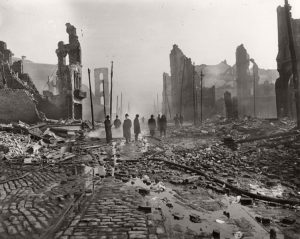This, you may be a little surprised to read, is a story about a “two-piece bustle dress of bronze silk with striped rust velvet accents and lace cuffs“, with original Ophelia-motif buttons. Maryland-based curator and antique dress collector Sara Rivers-Cofield bought it for a Benjamin from an antique mall around Christmas 2013: but it turned out – marvel of marvels – to have an odd-looking ciphertext concealed in a secret inside pocket.

In early 2014, German crypto-blogger Klaus Schmeh threw this puzzle to his readers to solve, not unlike a juicy bone to a pack of wolves. However, their voracious code-breaking teeth – normally reliable enough for enciphered postcards and the like – seemed not to gain any grip on this silk dress cipher, even when he revisited it a few days ago.
So… what is going on here? Why can’t we just shatter its cryptographic shell, like the brittle antique walnut it ought by all rights to be? And what might be the cipher’s secret history?
First, The Dress
It’s made of nice quality silk (and has been looked after well over its 130-odd year lifetime), so would have been a pricey item. The buttonholes are hand-stitched (and nicely finished), yet much of the other stitching was done by machine.
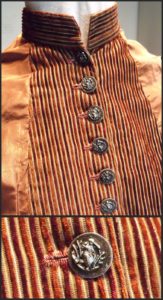
This alone would date the item to after 1850 or so (when Isaac Singer’s sewing machines began to be sold in any quantity). However, Sara Rivers-Cofield dates it (on purely stylistic grounds) to “the mid-1880s”, which I find particularly interesting, for reasons I’ll explain later.
All we know about its original owner, apart from a penchant for hidden ciphers, is her surname (“Bennett”) and her dress size. We might reasonably speculate (from the cost and quality of her silk two-piece) that she was somewhere between well-to-do and very well off; and perhaps from a larger city in Maryland (such as Baltimore) where silk would be more de rigueur; and possibly she wasn’t much beyond her mid-20s (because life expectancy wasn’t that good back then).
Who Might She Be?
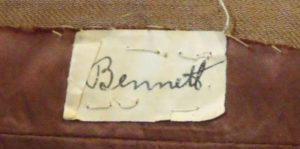
It doesn’t take much web searching to come up with a plausible-sounding candidate: Margaret J. Bennett, “a dowager grand dame of Baltimore society” (according to the Baltimore Sun) who died childless in 1900, leaving $150,000 to endow a local trust to provide accommodation for homeless women.
Among Baltimore architectural historians, she is also remembered for the Bennett House at 17 West Mulberry Street: there, the land was purchased by F.W. Bennett (who was the head of his own Auction House in town), while the house was erected in 1880.
Anyway, if anyone here has access to American newspapers archives or Ancestry.com (though I have in the past, I don’t at the moment), I’d be very interested to know if they have anything on Margaret J. Bennett. I didn’t manage to find any family archives or photographs online, but hopefully you cunning people can do much better.
Of course, there may well be many other Mrs Bennetts who also match the same basic profile: but I think Margaret J. is too good a catch not to have at least a quick look. 🙂
Now, The Silk Dress Cipher Itself
What Sara Rivers-Cofield (and her mother) found hidden inside the silk dress’s secret inner pocket were two balled-up sheets of paper (she called them “The Bustle Code”):
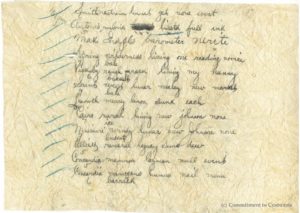
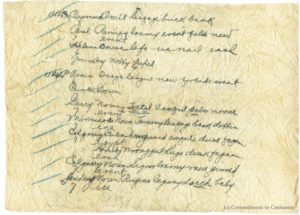
Within a few seconds of looking at these, it was clear to me that what we have here is a genuine cipher mystery: that is, something where the cryptography and the history are so tangled that each obscures the other.
Curiously, the writing on the sheets is very structured: each line consists of between two and seven words, and all bar three of these have the number of words written in just below the first word. So even when text wraps round, it appears that we can treat that whole (wrapped) line as a single unit.
Also oddly, the writing is constrained well within the margins of the paper, to the point that there almost seems to be an invisible right-hand margin beyond which the writer did not (or could not) go. It therefore seems as though these sheets might be a copy of a document that was originally written on much narrower pieces of paper, but where the original formatting was retained.
Another point that’s worth making is that the idea of using word lists for telegraphy (and indeed cryptography) is to keep the words dissimilar to each other, to prevent messages getting scrambled. Yet here we appear to have words very similar to each other (such as “leafage” and “leakage”), along with words that seem to have been misheard or misspelt (“Rugina” for “Regina”, “Calgarry” for “Calgary”, etc).
To me, this suggests that part of the process involved somebody reading words out loud to someone writing them down. Hence I’ve attempted to correct parts of my transcription to try to bring some semblance of uniformity to it. (But feel free to disagree, I don’t mind).
Interestingly, if you lay out all the words in columns (having unwrapped the word wrapping), a number of striking patterns emerge…
The Column Patterns
Where the codetext’s words repeat, they do so in one of three groups: within the first column (e.g. “Calgarry”), within the second column (e.g. “Noun”), or within the remainder (e.g. “event”). In the following image, I’ve highlighted in different colours where words starting with the same letter repeat from column three onwards:
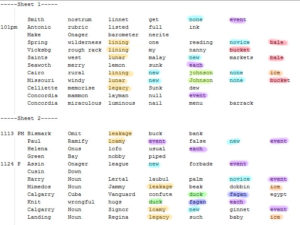
Moreover, the words in the first column are dominated by American and Canadian place names: although (just to be difficult) “egypt” and “malay” both appear elsewhere in the lines.
The third column is overwhelmingly dominated by l-words (legacy, loamy, etc): generally, words in the third to seventh columns start with a very limited range of letters, one quite unlike normal language initial letter distributions.
Indeed, this strongly suggests to me that the four instances of “Noun” in the second column are all nulls, because if you shift the remainder of those words across by one column, “laubul” / “leakage” / “loamy” / “legacy” all slide from column #4 back into the l-initial-heavy column #3.
It seems almost impossible at this point not to draw the conclusion that these words are drawn from lists of arbitrary words, arranged by first letter: and that without access to those same lists, we stand no real chance of making progress.
All the same, a commenter on Sara Rivers-Cofield’s blog (John McVey, who collects historical telegraph codes, and who famously – “famously” around here anyway – helped decode a 1948 Israeli telegram recently) proposed that what was in play might be not so much a telegraphic code as a telegraphic cipher.
These (though rare) included long lists of words to yield numerical equivalents, which could then be used to index into different lists (or sometimes the same list, but three words onwards). Here’s a link to an 1870 telegraphic cypher from McVey’s blog.
However, from the highly-structured nature of the word usage and repetitions here, I think we can rule out any kind of formal telegraphic code, i.e. this is not in any way a “flat” words-in-words-out code substitution.
Rather, I think that we are looking at something similar to the semi-improvised (yet complex) rum-runner codes that Elizebeth Friedman won acclaim for breaking in the 1920s and 1930s: strongly reliant on code lists, yet also highly specialized around the precise nature of the contents of the communication, and using amateur code-making cunning.
That is, the first two columns seem to be encoding a quite different type of content to the other columns: the l-list words seem to be signalling the start of the second half’s contents.
Were Other People Involved?
I’ve already suggested that the words on the two sheets were copied from smaller (or at least narrower) pieces of paper, and that as part of this someone may well have read words out for someone else to copy down (because spelling mistakes and/or mishearing mistakes seem to have crept in).
However, someone (very possibly a third person) has also apparently checked these, ticking each numbered line off with a rough green pencil. There are also underlinings under some words (such as “Lental”), not unlike a schoolteacher marking corrections on an exercise book.
Yet once you start to get secret writing with as many as three people involved, the chances of this being an individual’s private code would seem to sharply reduced – that is, I think we can rule out the possibility that this was the delusional product of a “lone gunman”. Moreover, there must surely have been a good-sized pie involved to warrant the effort of buying (or, perhaps more likely given the idiosyncratic nature of the words) assembling code books: by which I mean there was enough benefit to be divided into at least three slices and still be worth everyone’s while.
What I’m trying to get at here is that, from the number of people involved, the tangledness of the code books, and the curious rigid codetext structure, that this seems to have been an amateur code system constructed to enable some kind of organized behaviour.
Betting springs obviously to mind here: and possibly horse-racing, given that “dobbin” and “onager” appear in the codewords. But there’s another possibility…
Numbers and policies?
With its Puritan historical backdrop, America has long had an ambivalent attitude towards both gambling and alcohol: the history of casinos, inter-state gambling, and even Prohibition all attest strongly to this.
By the 1880s, the kind of state or local lotteries that had flourished at the start of that same century had almost all been shut down, victims of corruption and scandals. The one that remained (the Louisiana Lottery) was arguably even more corrupt than the others, but remained afloat thanks to the number of politicians benefiting from it: in modern political argot, it was (for a while, at least) “too big to fail”.
What stepped into the place of the state lotteries were illegal local lotteries, better known as the “numbers game”, or the numbers racket. Initially, these were unofficial lotteries run from private residences: but later (after the 1920s, I believe), they began to instead use numbers printed in newspapers that were believed to be random (such as the last three digits of various economic indicators, such as the total amount of money taken at a given racetrack), because of – surprise, surprise – the same kinds of corruption and rigging that had plagued the early official state lotteries.
Though the numbers racket became known as the scourge of Harlem in the first half of the twentieth century (there’s a very good book on this, “Playing the Numbers: Gambling in Harlem between the Wars”), modern state lotteries and interstate sports betting all but killed it off, though a few numbers joints do still exist (“You’re too late to play!“).
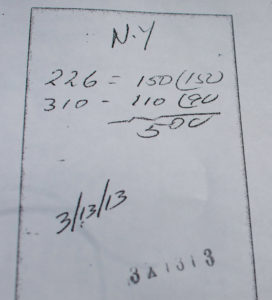
Back in the second half of the 19th century, ‘policy shops’ (where the question “do you want to buy a policy?” drew a parallel between insurance and gambling) started to flourish, eventually becoming a central feature of the American urban landscape. With more and more state lotteries being shut down as the century progressed, numbers were arguably the face of small-stake betting: in terms of accessibility, they were the equivalent of scratch cards, available nearly everywhere.
For a long time, though, information was king: if you were organized enough to get access to the numbers before the policy shop did, you could (theoretically) beat the odds. Winning numbers were even smuggled out by carrier pigeon: yet policy shops (who liked to take bets right up until the last possible moment) were suspicious of “pigeon numbers”, and would often not pay out if they caught so much as a sniff of subterfuge. It’s not as if you could complain to the police, right?
At the same time, a whole hoodoo culture grew up around numbers, where superstitious players were sold incense sticks, bath crystals, and books linking elements in your dreams to numbers. First published in 1889, one well-known one was “Aunt Sally’s Policy Player’s Dream Book”:
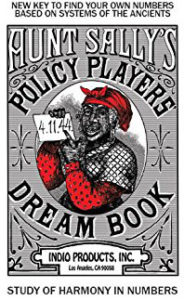
This contained lists linking dream-items to suggestions of matching number sequences to back, with two numbers being a “saddle”, three numbers a “gig”, and four numbers a “horse”: on the book’s cover, Aunt Sally is shown holding up “the washerwoman’s gig” (i.e. 4.11.44). There’s much more about this on Cat Yronwode’s excellent Aunt Sally page.
Might it be that these two Silk Dress Cipher sheets are somehow numbers betting slips that have been encoded? Could it be that each line somehow encodes a name (say, the first two columns), the size of the bet, and a set of numbers to bet on? There were certainly illegal lotteries and policy shops in Baltimore, so this is far from impossible.
Right now, I don’t know: but I’d be very interested to know of any books that cover the history of “policy shops” in the 19th century. Perhaps the clues will turn out to be somewhere under The Baltimore Sun…
